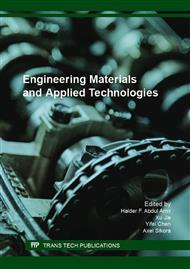[1]
CSIR Building and Construction Technology, Reusing construction and demolition waste, Technobrief, June (2000).
Google Scholar
[2]
Chakradhara Rao, M., Bhattacharyya, S., & Barai, S. (2010). Behaviour of recycled aggregate concrete under drop weight impact load. Construction and Building Materials.
DOI: 10.1016/j.conbuildmat.2010.06.055
Google Scholar
[3]
Rao, A., Jha, K. N., & Misra, S. (2007). Use of aggregates from recycled construction and demolition waste in concrete. Resources, Conservation and Recycling, 50(1), 71-81.
DOI: 10.1016/j.resconrec.2006.05.010
Google Scholar
[4]
H. Kawano, The state of reuse of demolished concrete in Japan. Hakodate, Japan: E & FN Spon, (1996).
Google Scholar
[5]
Padmini, A., Ramamurthy, K., & Mathews, M. (2009). Influence of parent concrete on the properties of recycled aggregate concrete. Construction and Building Materials, 23(2), 829-836.
DOI: 10.1016/j.conbuildmat.2008.03.006
Google Scholar
[6]
M.V.S.S. Sastri, K. Jagannadha Rao, B.L.P. Swami, & Bhikshma, V., Strength Characteristics of Triple Blended Recycled Aggregate Concrete Mixes, in 3rd International Conference on Recent Trends in Engineering & Technology (ICRTET, 2014), Chandwad, Nashik, India, 2014, pp.557-563.
Google Scholar
[7]
Mandal, S., Chakraborty, S., & Gupta, A. (2002). Some studies on durability of recycled aggregate concrete. Indian Concrete Jounral, 76(6), 385-388.
Google Scholar
[8]
Zaharieva, R., Buyle-Bodin, F., Skoczylas, F., & Wirquin, E. (2003), Assessment of the surface permeation properties of recycled aggregate concrete. Cement and Concrete Composites, 25(2), pp.223-232.
DOI: 10.1016/s0958-9465(02)00010-0
Google Scholar
[9]
T. C. Hansen, Recycled aggregates and recycled aggregate concrete second state-of-the-art report developments 1945–1985, Materials and Structures, vol. 19, pp.201-246, (1986).
DOI: 10.1007/bf02472036
Google Scholar
[10]
R. E. Beddoe and H. W. Dorner, Modelling acid attack on concrete: Part I. The essential mechanisms, Cement and Concrete Research, vol. 35, pp.2333-2339, (2005).
DOI: 10.1016/j.cemconres.2005.04.002
Google Scholar
[11]
IS: 12269-1987. Indian standard specification for 53 grade ordinary Portland cement. New Delhi.
Google Scholar
[12]
IS: 383-1970, Indian standard specifications for coarse and fine aggregate for the Natural sources for concrete, Bureau of Indian Standards, New Delhi.
Google Scholar
[13]
Rao, K. Jagannadha, and T. Ahmed Khan, Suitability of Glass Fibers in High Strength Recycled Aggregate Concrete-an Experimental Investigation, Asian Journal of Civil Engineering (Building and Housing) 10, no. 6 (2009), pp.681-89.
Google Scholar
[14]
Rao, K. Jagannadha, M.V.S.S. Sastri, and K. Sridhar, Behaviour of High Strength Concrete with Recycled Aggregate and Fly Ash., In Research, Development, and Practice in Structural Engineering and Construction, Perth: Research Publishing, (2012).
DOI: 10.3850/978-981-08-7920-4_m-51-0381
Google Scholar


